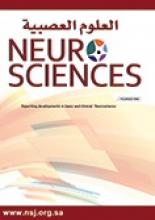Abstract
OBJECTIVE: To illustrate through 10 pediatric cases, the clinical features, course, and importance of neuroimaging (especially MRI) in guiding the diagnosis of acute disseminated encephalomyelitis (ADEM) and controlling patients after treatment.
METHODS: A retrospective review of 10 pediatric cases of ADEM, with special regard to the MRI features, presenting to the Pediatric Departments, Hedi Chaker Hospital, Sfax, Tunisia between January 2002 and December 2008.
RESULTS: Children with ADEM presented with variable and multiple neurological signs most often occurring after an infectious episode, especially after upper respiratory tract infection. The MRI permitted confirmation of the diagnosis by showing demyelinating lesions either in the brainstem, the cerebellum, the cerebral white and grey matter, or in the spine of all patients.
CONCLUSION: Acute disseminated encephalomyelitis is characterized by multifocal demyelinating lesions resulting in varied neurological signs. The MRI is the technique of choice to show these lesions.
- Copyright: © Neurosciences
Neurosciences is an Open Access journal and articles published are distributed under the terms of the Creative Commons Attribution-NonCommercial License (CC BY-NC). Readers may copy, distribute, and display the work for non-commercial purposes with the proper citation of the original work.






